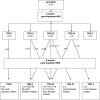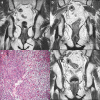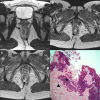The assessment of local response using magnetic resonance imaging at 3- and 6-month post chemoradiotherapy in patients with anal cancer
- PMID: 27090113
- PMCID: PMC5209434
- DOI: 10.1007/s00330-016-4337-z
The assessment of local response using magnetic resonance imaging at 3- and 6-month post chemoradiotherapy in patients with anal cancer
Abstract
Objectives: To assess the use of MRI-determined tumour regression grading (TRG) in local response assessment and detection of salvageable early local relapse after chemoradiotherapy (CRT) in patients with anal squamous cell carcinoma (ASCC).
Methods: From a prospective database of patients with ASCC managed through a centralised multidisciplinary team, 74 patients who completed routine post-CRT 3- and 6-month MRIs (2009-2012) were reviewed. Two radiologists blinded to the outcomes consensus read and retrospectively assigned TRG scores [1 (complete response) to 5 (no response)] and related these to early local relapse (within 12 months) and disease-free survival (DFS).
Results: Seven patients had early local relapse. TRG 1/2 scores at 3 and 6 months had a 100 % negative predictive value; TRG 4/5 scores at 6 months had a 100 % positive predictive value. All seven patients underwent salvage R0 resections. We identified a novel 'tram-track' sign on MRI in over half of patients, with an NPV for early local relapse of 83 % at 6 months. No imaging characteristic or TRG score independently prognosticated for late relapse or 3-year DFS.
Conclusions: Post-CRT 3- and 6-month MRI-determined TRG scores predicted salvageable R0 early local relapses in patients with ASCC, challenging current clinical guidelines.
Key points: • Post-chemoradiotherapy MRI (3 and 6 months) helps local response assessment in ASCC. • The MRI-TRG system can be used reproducibly in patients with ASCC. • The TRG system facilitates patient selection for examination under anaesthesia and biopsy. • The use of MRI-TRG predicts for detection of salvageable early local relapses. • The TRG system allows for a standardised follow-up pathway.
Keywords: Anus neoplasms; Carcinoma, squamous cell; Chemoradiotherapy; Magnetic resonance imaging; Tumour response.
Figures






References
-
- UKCCCR Epidermoid anal cancer: results from the UKCCCR randomised trial of radiotherapy alone versus radiotherapy, 5-fluorouracil, and mitomycin. UKCCCR Anal Cancer Trial Working Party. UK Co-ordinating Committee on Cancer Research. Lancet. 1996;348:1049–1054. doi: 10.1016/S0140-6736(96)03409-5. - DOI - PubMed
-
- Ajani JA, Winter KA, Gunderson LL, Pedersen J, Benson AB, 3rd, Thomas CR, Jr, Mayer RJ, Haddock MG, Rich TA, Willett C. Fluorouracil, mitomycin, and radiotherapy vs fluorouracil, cisplatin, and radiotherapy for carcinoma of the anal canal: a randomized controlled trial. JAMA. 2008;299:1914–1921. doi: 10.1001/jama.299.16.1914. - DOI - PubMed
-
- James RD, Glynne-Jones R, Meadows HM, Cunningham D, Myint AS, Saunders MP, et al. Mitomycin or cisplatin chemoradiation with or without maintenance chemotherapy for treatment of squamous-cell carcinoma of the anus (ACT II): a randomised, phase 3, open-label, 2 x 2 factorial trial. Lancet Oncol. 2013;14:516–524. doi: 10.1016/S1470-2045(13)70086-X. - DOI - PubMed
MeSH terms
LinkOut - more resources
Full Text Sources
Other Literature Sources
Medical
Molecular Biology Databases
Research Materials

